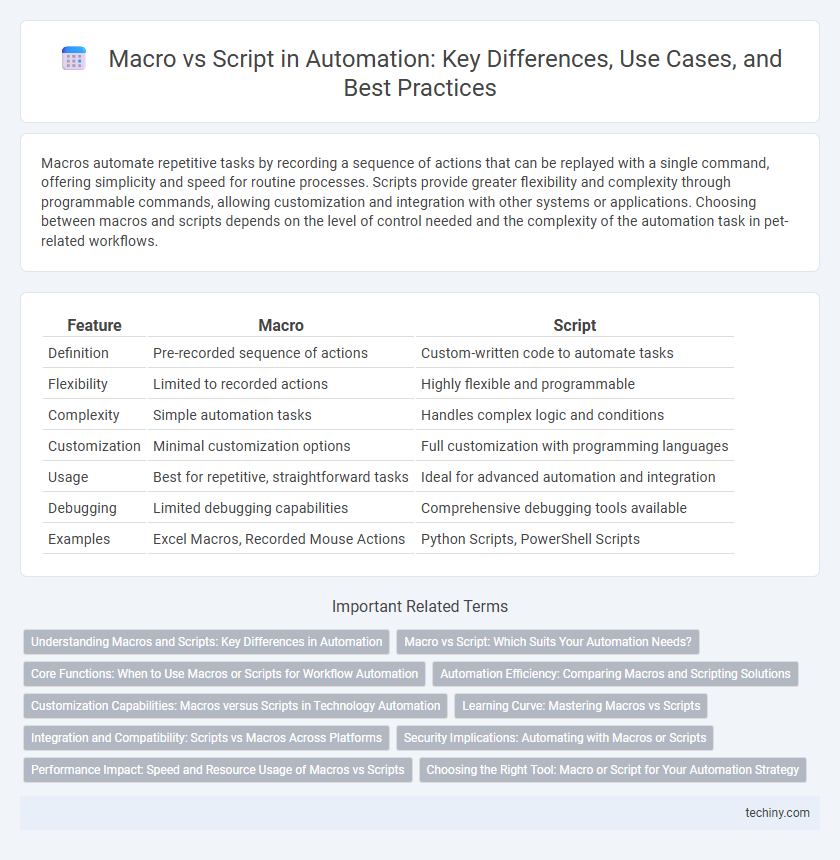Macros automate repetitive tasks by recording a sequence of actions that can be replayed with a single command, offering simplicity and speed for routine processes. Scripts provide greater flexibility and complexity through programmable commands, allowing customization and integration with other systems or applications. Choosing between macros and scripts depends on the level of control needed and the complexity of the automation task in pet-related workflows.
Table of Comparison
| Feature | Macro | Script |
|---|---|---|
| Definition | Pre-recorded sequence of actions | Custom-written code to automate tasks |
| Flexibility | Limited to recorded actions | Highly flexible and programmable |
| Complexity | Simple automation tasks | Handles complex logic and conditions |
| Customization | Minimal customization options | Full customization with programming languages |
| Usage | Best for repetitive, straightforward tasks | Ideal for advanced automation and integration |
| Debugging | Limited debugging capabilities | Comprehensive debugging tools available |
| Examples | Excel Macros, Recorded Mouse Actions | Python Scripts, PowerShell Scripts |
Understanding Macros and Scripts: Key Differences in Automation
Macros automate repetitive tasks by recording a sequence of user actions within software, typically designed for straightforward, rule-based processes. Scripts consist of written code using programming languages like Python or JavaScript, allowing for more complex logic, conditional statements, and integration with external systems. Understanding the differences in flexibility, complexity, and use cases helps optimize automation strategies across various applications.
Macro vs Script: Which Suits Your Automation Needs?
Macros automate repetitive tasks by recording user actions and replaying them without coding, ideal for simple, straightforward processes. Scripts offer greater flexibility and control through custom coding, enabling complex automation across diverse applications and workflows. Choosing between macros and scripts depends on the automation complexity, user coding skills, and scalability requirements.
Core Functions: When to Use Macros or Scripts for Workflow Automation
Macros automate repetitive tasks within specific software applications by recording user actions and replaying them to streamline workflows. Scripts offer greater flexibility and control by allowing custom code to execute complex sequences, integrate multiple applications, and handle conditional logic. Use macros for simple, repetitive tasks confined to one platform and scripts when workflows require advanced logic, cross-application automation, or scalability.
Automation Efficiency: Comparing Macros and Scripting Solutions
Macros offer quick automation for repetitive tasks within specific applications, making them ideal for routine, predefined workflows. Scripting solutions provide greater flexibility and scalability, enabling complex logic, integration with multiple systems, and advanced error handling. Choosing between macros and scripts hinges on the required automation complexity and long-term maintenance needs.
Customization Capabilities: Macros versus Scripts in Technology Automation
Macros offer basic customization capabilities by recording repetitive tasks, enabling users to automate simple workflows without deep programming knowledge. Scripts provide advanced customization through coding languages like Python or JavaScript, allowing for complex logic, conditional operations, and integration with multiple systems. This makes scripts highly versatile for tailored automation solutions in diverse technological environments.
Learning Curve: Mastering Macros vs Scripts
Macros offer a gentler learning curve, enabling users to automate repetitive tasks through record-and-playback features without deep programming knowledge. Scripts require a more advanced understanding of coding languages like VBA or Python, demanding greater initial effort but providing enhanced flexibility and power. Mastering scripts unlocks complex automation possibilities beyond the capabilities of standard macros.
Integration and Compatibility: Scripts vs Macros Across Platforms
Scripts offer greater integration and compatibility across multiple platforms by using programming languages such as Python or JavaScript, enabling seamless automation in diverse environments. Macros, typically built within specific software like Excel or Word, provide more limited interoperability and often do not transfer well outside their native applications. Choosing scripts over macros enhances cross-platform workflow automation and system-level interaction.
Security Implications: Automating with Macros or Scripts
Macros typically pose higher security risks due to their integration with applications like Microsoft Office, making them common vectors for malware and unauthorized access. Scripts, while potentially more powerful and flexible, require strict execution policies and proper environment isolation to prevent exploitation through malicious code. Implementing rigorous code validation and restricting macro or script execution to trusted sources mitigates vulnerabilities in automation workflows.
Performance Impact: Speed and Resource Usage of Macros vs Scripts
Macros often execute faster than scripts due to their direct interaction with application functions and minimal overhead, making them well-suited for repetitive tasks with limited complexity. Scripts, while potentially slower, offer greater flexibility and can handle complex logic, but they may consume more system resources during execution. Choosing between macros and scripts depends on the balance between speed requirements and the need for advanced automation capabilities within the specific software environment.
Choosing the Right Tool: Macro or Script for Your Automation Strategy
Choosing between a macro and a script hinges on the complexity and scalability of your automation needs; macros excel in automating repetitive tasks within specific applications, offering user-friendly interfaces and quick deployment. Scripts provide greater flexibility and power, supporting complex logic, integration with multiple systems, and customization through programming languages like Python or JavaScript. Evaluating factors such as task complexity, required customization, environment compatibility, and long-term maintenance ensures the selection of the most efficient and sustainable automation tool for your strategy.
Macro vs Script Infographic

 techiny.com
techiny.com